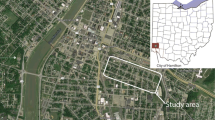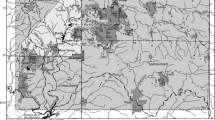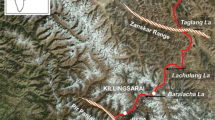Abstract
Anthropogenic contributions of lead to the urban environment havebeen dominated by combustion of leaded gasoline. A number of studies have used lead concentrations in road deposited sediments(RDSs) to infer automobile contributions. However, few studies have combined concentration data, enrichment ratios, and lead isotope ratio data into a comprehensive picture of lead contamination of road sediments. An urban, non-industrialized basin, in Oahu, Hawaii, was selected for investigation. Twenty RDSsamples were collected throughout the 11 km2 system, with anundisturbed soil profile sampled to a depth of 30 cm to documentbackground lead levels.Median lead concentrations from a weak (cold) HCl digestion and a hot nitric acid digestion were 3 and 7 mg kg-1 for thebackground soil, and 256 and 303 mg kg-1 for RDSs. The median Pb enrichment ratio (HCl digestion) for RDSs was 129, witha range from 24 to 883. All the data collected point to a highlycontaminated environment.Lead isotope ratios from potential sources were examined relativeto those observed for RDSs in the system. Host geological rocks,paint, and long-range aerosol transport were ruled-out as significant sources based on an examination of isotope ratios andpotential loadings to road sediments. Leaded gasoline wasidentified as the major contributor to present-day road sedimentsbased on their radiogenic nature, with mean 206Pb/204Pb = 18.787 ± 0.096 (95% confidence interval), 207Pb/204Pb = 15.847± 0.074, 208Pb/204Pb= 38.836 ± 0.221, and 206Pb/207Pb = 1.184 ± 0.009. The contribution of gasoline additives to RDS for two periods, pre-1968 and post-1968, were estimated using 206Pb/207Pb ratios. The average contribution of post-1968 lead to RDSs was 59%, with a range from 32 to 81%. To explain the mixed age of lead in the RDSs, we suggest that erosional processes have mobilized sediment from roadside reservoirs in the basin that have accumulated automobile emissions primarily since the 1930s. The significant shift in useof radiogenic (J-type) ores, mostly from Missouri, USA, have allowed us to fingerprint and apportion lead in RDSs of thissystem.
Similar content being viewed by others
References
Aberg, G., Stray, H. and Dahlin, E.: 1999, ‘Impact of pollution at a stone age rock art site in Oslo, Norway, studied using lead and strontium isotopes’, J. Arch. Sci. 26, 1483–1488.
Abouchami, W., Galer, S. J. G. and Hofmann, A.W.: 2000, ‘High precision lead isotope systematics of lavas from the Hawaiian scientific drilling project’, Chem. Geol. 169, 187–209.
Adgate, J. L., Rhoads, G. G. and Lioy, P. J.: 1998, ‘The use of isotope ratios to apportion sources of lead in Jersey City, NJ, house dust wipe samples’, Sci. Total Environ. 221, 171–180.
Ault, W. U., Senechal, R. G. and Erlebach, W. E.: 1970, ‘Isotopic composition as a natural tracer of lead in the environment’, Environ. Sci. Technol. 4, 305–313.
Betzer, P. R., Carder, K. L., Duce, R. A., Merrill, J. T., Tindale, N.W., Uematsu, M., Costello, D. K., Young, R. W., Feely, R. A., Breland, J. A., Bernstein, RE. and Greco, A. M.: 1988, ‘Long-range transport of giant mineral aerosol particles’, Nature 336, 568–571.
Brown, J. S.: 1962, ‘Ore leads and isotopes’, Econ. Geol. 57, 673–720.
Brown, J. S.: 1967, ‘Isotopic Zoning of Lead and Sulfur in Southeast Missouri’, in J. S. Brown (ed.), Genesis of Stratiform Lead-Zinc-Barite-Fluorite Deposits (Mississippi Valley Type Deposits), Economic Geology Monograph 3, Lancaster Press, Inc., PA, pp. 410–426.
Chisholm, W., Rosman, K. J. R., Boutron, C. F., Candelone, J.-P. and Hong, S.: 1995, ‘Determination of lead isotopic ratios in Greenland and Antarctic snow and ice at picogram per gram concentrations’, Anal. Chimica Acta 311, 141–151.
Chow, T. J. and Johnstone, M. S.: 1965, ‘Lead isotopes in gasoline and aerosols of Los Angeles Basin, California’, Science 147, 502–503.
Chow, T. J., Snyder, C. B. and Earl, J. L.: 1975, ‘Isotope Ratios of Lead as Pollutant Source Indicators’, Proceedings of a Symposium on Isotope Ratios as Pollutant Source and Behaviour Indicators, Vienna, 18-22 November 1974. International Atomic Energy Agency, Vienna, IAEA-SM-191/4, pp. 95–108.
City and County of Honolulu: 1980, ‘Neighborhood Data Book Palolo’, Prepared by the Office of Human Resources, City and County of Honolulu, Honolulu, Hawaii.
Clague, D. A. and Frey, F. A.: 1982, ‘Petrology and trace element geochemistry of the Honolulu volcanics, Oahu: implications for the mantle below Hawaii’,J. Petrol. 23, 447–504
Cleveland, W. S. and Devlin, S. J.: 1988, ‘Locally weighted regression: an approach to regression analysis by local fitting’, J. Am. Stat. Assoc. 83, 596–610.
Crocetti, C. A., Holland, H. D. and McKenna, L.W.; 1988, ‘Isotopic composition of lead in Galenas from the Viburnum Trend, Missouri’, Econ. Geol. 83, 355–376.
Davidson, C. I.: 1999 (editor), Clean Hands: Clair Patterson's Crusade Against Environmental Lead Contamination, Nova Science Publishers, Inc., Commack, New York, pp. xvii to xxxiv.
De Carlo, E. H. and Anthony, S. S.: 2002, ‘Spatial and temporal variability of trace element concentrations in an urban subtropical watershed, Honolulu, Hawaii’, Appl. Geochem. 17, 475–492.
Eiler, J. M., Farley, K. A. and Stopler, E. M.: 1998, ‘Correlated helium and lead isotope variations in Hawaiian Lavas’, Geochim. Cosmochim. Acta 62, 1977–1984.
Erel, Y. and Patterson, C. C.: 1994, ‘Leakage of industrial lead into the hydrocycle’, Geochim. Cosmochim. Acta 58, 3289–3296.
Facchetti, S.: 1989, ‘Lead in petrol: the isotopic lead experiment’, Accounts Chem. Res. 22, 370–374.
Faure, G.: 1986, Principles of Isotope Geology, 2nd ed., New York, NY, Wiley.
Frey, F. A., Garcia, M. O. and Roden, M. F.: 1994, ‘Geochemical characteristics of Koolau Volcano: implications of intershield geochemical differences among Hawaiian volcanoes’, Geochim. Cosmochim. Acta 58, 1441–1462.
Graney, J. R., Halliday, A. N., Keeler, G. J., Nriagu, J. O., Robbins, J. A. and Norton, S. A.: 1995, ‘Isotopic record of lead pollution in lake sediments from the Northeastern United States’, Geochim. Cosmochim. Acta 59, 1715–1728.
Gulson, B. L., Davis, J. J., Mizon, K. J., Korsch, M. J. and Bawden-Smith, J.: 1995, ‘Sources of lead in soil and dust and the use of dust fallout as a sampling medium’, Sci. Total Environ. 166, 245–262.
Hauri, E. H.: 1996, ‘Major-element variability in the Hawaiian mantle plume’, Nature 382, 415–419.
Hauri, E. H., Lassiter, J. C. and DePaolo, D. J.: 1996, ‘Osmium isotope systematics of drilled lavas from Mauna Loa, Hawaii’, J. Geophys. Res. 101, 11,793–11, 806.
Heyl, A. V., Delevaux, M. H., Zartman, R. E. and Brock, M. R.: 1966, ‘Isotopic study of galenas from the upper Mississippi Valley, the Illinois-Kentucky, and some Appalachian Valley Mineral Districts’, Econ. Geol. 61, 933–961.
Hinners, T. A., Heithmar, E. M., Spittler, T. M. and Henshaw, J. M.: 1987, ‘Inductively coupled plasma mass spectrometric determination of lead isotopes’, Anal. Chem. 59, 2658–2662.
Hirao, Y. and Patterson, C. C.: 1974, ‘Lead aerosol pollution in the High Sierra Overrides Natural Mechanisms which exclude lead from a food chain’, Science 184, 989–992.
Hurst, R. W.: 2000, ‘Applications of anthropogenic lead archaeostratigraphy (ALAS model) to hydrocarbon remediation’, Environ. Forensics 1, 11–23.
Hurst, R. W., Davis, T. E. and Chinn, B. D.: 1996, ‘The lead fingerprints of fasoline contamination’, Environ. Sci. Technol. 30, 304A–307A.
Ikeno, D. E.: 1996, ‘Urban Runoff in Manoa and Palolo Streams’, Unpublished Master of Science Thesis, Civil Engineering, University of Hawaii, 186 pp.
Jaeger, R. J., Weiss, A. L. and Manton, W. I.: 1998, ‘Isotopic ratio analysis in residential lead-based paint and associated surficial dust’, Clinical Toxicol. 36, 691–703.
Jones, C. E., Halliday, A. N., Rea, D. K. and Owen, R. M.: 2000, ‘Eolian inputs of lead to the North Pacific’, Geochim. Cosmochim. Acta 64, 1405–1416.
Kempton, P. D.: 1995, ‘Common Pb Chemical Procedures for Silicate Rocks and Minerals, Methods of Data Correction and an Assessment of Data Quality at the NERC Isotope Geosciences Laboratory’, NERC Isotope Geosciences Laboratory Report Series No. 78, England, UK, 26 pp.
Kennedy, A. K., Kwon, S.-T., Frey, F. A. and West, H. B.: 1991, ‘The isotopic composition of postshield lavas from Mauna Kea Volcano, Hawaii’, Earth Planet. Sci. Lett. 103, 339–353.
Kurz, M. D. and Kammer, D. P.: 1991, ‘Isotopic evolution of Mauna Loa Volcano’, Earth Planet. Sci. Lett. 103, 257–269.
Lanphere, M. A. and Dalrymple, G. B.: 1980, ‘Age and strontium isotopic composition of the Honolulu Volcanic Series, Oahu, Hawaii’,Am. J. Sci. 280-A, 736–751.
Leeman, W. P., Gerlach, D. C., Garcia, M. O. and West, H. B.: 1994, ‘Geochemical variations in lavas from Kahoolawe Volcano, Hawaii: evidence for open system evolution of plume-derived magmas’, Contrib. Mineral. Petrol. 116, 62–77.
Long, K. R., DeYoung, J. H., Jr. and Ludington, S.: 2000, ‘Significant deposits of gold, silver, copper, lead, and zinc in the United States’, Econ. Geol. 95, 629–644.
Manton, W. I.: 1977, ‘Source of lead in blood’, Arch. Environ. Health 32, 149–159.
Mielke, H. W.: 1999, ‘Lead in the inner cities’, Am. Scientist 87, 62–73.
Monna, F., Lancelot, J., Croudace, I. W., Cundy, A. B. and Lewis, J. T.: 1997, ‘Pb isotopic composition of airborne particulate material from France and the Southern United Kingdom: implications for Pb pollution sources in urban areas’, Environ. Sci. Technol. 31, 2277–2286.
Nageotte, S. M. and Day, J. P.: 1998, ‘Lead concentrations and isotope ratios in street dust determined by electrothermal atomic absorption spectrometry and inductively coupled plasma mass spectrometry’, Analyst 123, 59–62.
Nriagu, J. O.: 1990, ‘The rise and fall of leaded gasoline’, Sci. Total Environ. 92, 13–28.
Patterson, C. C.: 1965, ‘Contaminated and natural lead environments of man’, Arch. Environ. Health 11, 344–360.
Patterson, C. C. and Settle, D. M.: 1987, ‘Magnitude of lead flux to the atmosphere from volcanoes’, Geochim. Cosmochim. Acta 51, 675–681.
Rabinowitz, M. B.: 1987, ‘Stable isotope mass spectrometry in childhood lead poisoning’, Biol. Trace Element Res. 12, 223–229.
Rhodes, J. M. and Hart, S. R.: 1995, ‘Episodic Trace Element and Isotopic Variations in Historical Mauna Loa lavas: Implications for Magma and Plume Dynamics’, in J. M. Rhodes and J. P. Lockwood (eds), Mauna Loa Revealed-Structure, Composition, History, and Hazards. American Geophysical Union, Geophysical Monograph 92, Washington, DC, pp. 263–288.
Roden, M. F., Trull, T., Hart, S. R. and Frey, F. A.: 1994, ‘New He, Nd, Pb, and Sr isotopic constraints on the constitution of the Hawaiian Plume: results from Koolau Volcano, Oahu, Hawaii, U.S.A.’, Geochim. Cosmochim. Acta 58, 1431–1440.
Rosman, K. J. R., Chisholm, W., Boutron, C. F., Candelone, J.-P. and Hong, S.: 1994, ‘Isotopic evidence to account for changes in the concentration of Greenland snow between 1960 and 1988’, Geochim. Cosmochim. Acta 58, 3265–3270.
Russell, R. D. and Farquhar, R. M.: 1960, Lead Isotopes in Geology, Interscience Publishers Inc., New York, NY, 243 pp.
Shen, G. T. and Boyle, E. A.: 1987, ‘Lead in corals: reconstruction of historical industrial fluxes to the surface ocean’, Earth Planet. Sci. Lett. 82, 289–304.
Sherrell, R. M., Boyle, E. A. and Hamelin, B.: 1992, ‘Isotopic equilibration between dissolved and suspended particulate lead in the Atlantic Ocean: evidence from 210Pb and stable Pb isotopes’,J. Geophys. Res. 97 (C7), 11,257–11,268.
Shirahata, H., Elias, R. W. and Patterson, C. C.: 1980, ‘Chronological variations in concentrations and isotopic compositions of anthropogenic atmospheric lead in sediments of a remote subalpine pond’, Geochim. Cosmochim. Acta 44, 149–162.
Shotyk, W., Weiss, D., Appleby, P. G., Cheburkin, A. K., Frei, R., Gloor, M., Kramers, J. D., Reese, S. and Van Der Knaap, W. O.: 1998, ‘History of atmospheric lead deposition since 12,370 14C yr BP from a Peat Bog, Jura Mountains, Switzerland’, Science 281, 1635–1640.
Spencer, K. J., De Carlo E. H. and McMurtry, G. M.: 1995, ‘Isotopic clues to sources of natural and anthropogenic lead in sediments and soils from Oahu, Hawaii’, Pacific Sci. 49, 492–510.
State of Hawaii: 1996, State of Hawaii Data Book 1996 - A Statistical Abstract, Department of Business, Economic Development and Tourism, State of Hawaii, USA, 664 pp.
Stille, P., Unruh, D. M. and Tatsumoto, M.: 1983, ‘Pb, Sr, Nd and Hf isotopic evidence of multiple sources for Oahu, Hawaii Basalts’, Nature 304, 25–29.
Stille, P., Unruh, D. M. and Tatsumoto, M.: 1986, ‘Pb, Sr, Nd and Hf isotopic constraints on the origin of Hawaiian Basalts and evidence for a unique mantle source’, Geochim. Cosmochim. Acta 50, 2303–2319.
Stukas, V. J. and Wong, C. S.: 1981, ‘Stable lead isotopes as a tracer in coastal waters’, Science 211, 1424–1427.
Sturges, W. T. and Barrie, L. A.: 1989, ‘The use of stable lead 206/207 isotope ratios and elemental composition to discriminate the origins of lead in aerosols at a rural site in eastern Canada’, Atm. Environ. 23, 1645–1657.
Sugden, C. L., Farmer, J. G. and MacKenzie, A. B.: 1993, ‘Isotopic ratios of lead in contemporary environmental material from Scotland’, Environ. Geochem. Health 15, 59–65.
Sun, S.-S.: 1980 ‘Lead isotopic study of young volcanic rocks from mid-ocean ridges, ocean islands and island arcs’, Phil. Trans. Royal Soc. London 297A, 409–445.
Sutherland, R., Jelen, S. L. and Minton, G.: 1998, ‘High Efficiency Sweeping as an Alternative to the use of Wet Vaults for Stormwater Treatment’, in W. James (ed.),Advances in Modeling the Management of Stormwater Impacts, Vol. 6,CHI, Guelph, Canada, pp. 351–372.
Sutherland, R. A.: 2000, ‘Bed sediment-associated trace metals in an urban stream, Oahu, Hawaii’, Environ. Geol. 39, 611–627.
Sutherland, R. A. and Tolosa, C. A.: 2000, ‘Multi-element analysis of road-deposited sediment in an urban drainage basin, Honolulu, Hawaii’, Environ. Pollut. 110, 483–495.
Sutherland, R. A., Tolosa, C. A., Tack, F. M. G. and Verloo, M. G.: 2000, ‘Metal extraction from road sediment using different strength reagents: impact on anthropogenic contaminant signals’, Environ. Monitor. Assess. 71, 221–242.
Tatsumoto, M., Hegner, E. and Unruh, D. M.: 1987, ‘Origin of the West Maui Volcanic Rocks Inferred from Pb, Sr, and Nd Isotopes and a Multicomponent Model for Oceanic Basalt’, in R. W. Decker, T. L. Wright and P. H Stauffer (eds), Volcanism in Hawaii. Volume 1, U.S. Geological Survey Professional Paper 1350, US Government Printing Office, Washington, DC, pp. 723–744.
Tera, O., Schwartzman, D. W. and Watkins, T. R.: 1985, ‘Identification of gasoline lead in children's blood using isotopic analysis’,Arch. Environ. Health 40, 120–123.
Tommasini, S., Davies, G. R. and Elliott, T.: 2000, ‘Lead isotope composition of tree rings as biogeochemical tracers of heavy metal pollution: a reconnaissance study from Firenze, Italy’, Appl. Geochem. 15, 891–900.
Viczian, M., Lasztity, A. and Barnes, R. M.: 1990, ‘Identification of potential environmental sources of childhood lead poisoning by inductively coupled plasma mass spectrometry verification and case studies’, J. Anal. Atom. Spec. 5, 293–300.
Yafee, Y., Flessel, C. P., Wesolowski, J. J., Del Rosario, A., Guirgius, G. N., Matias, V., Degarmo, T. E., Coleman, D. C., Gramlich, J. W. and Kelly, W. R.: 1983, ‘Identification of lead sources in California children using the stable isotope ratio technique’,Arch. Environ. Health 38, 237–245.
Author information
Authors and Affiliations
Corresponding author
Rights and permissions
About this article
Cite this article
Sutherland, R.A., Day, J.P. & Bussen, J.O. Lead Concentrations, Isotope Ratios, and Source Apportionment in Road Deposited Sediments, Honolulu, Oahu, Hawaii. Water, Air, & Soil Pollution 142, 165–186 (2003). https://doi.org/10.1023/A:1022026612922
Issue Date:
DOI: https://doi.org/10.1023/A:1022026612922




